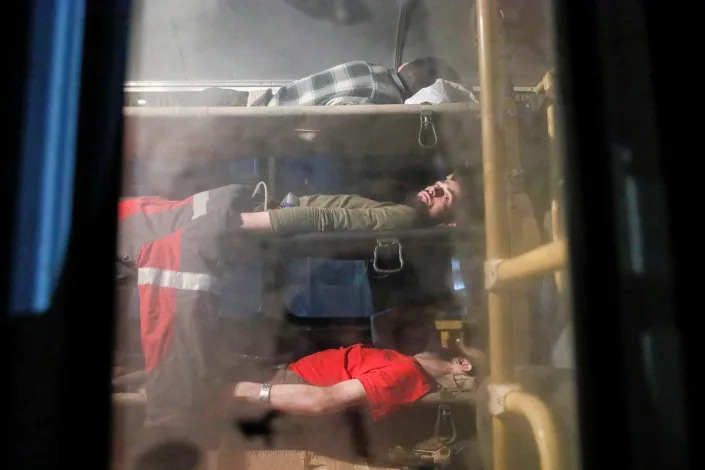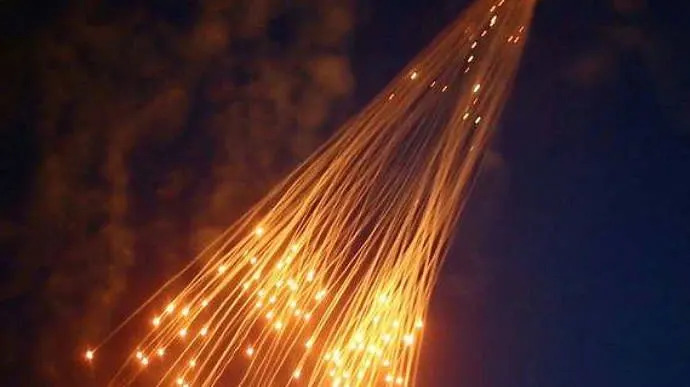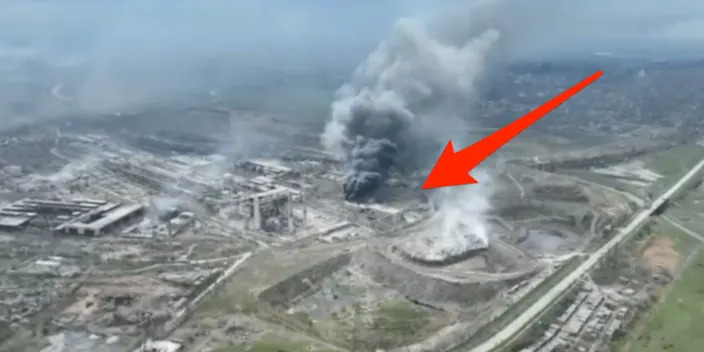Ukraine evacuates steel plant soldiers and says it has stopped fighting in an apparent surrender of Mariupol
Sinéad Baker
Tue, May 17, 2022
A screenshot from footage shared by the Mariupol City Council in April showing Russian forces striking the Azovstal steel plant in Mariupol, Ukraine with heavy artillery.
The soldiers holding a steel plant in Mariupol, southern Ukraine, were being evacuated Monday.
The troops resisted Russia for weeks, but were surrounded and vastly outgunned.
Ukraine avoided using the word "surrender," but conceded that its fight in Mariupol was over.
Ukraine evacuated its soldiers from the steel plant in the pivotal city that had become a last holdout against weeks of attacks, effectively ceding the city to Russia.
The soldiers had been in the Azovstal steel plant for weeks, with many of them wounded and without adequate supplies of food and water.
The steel plant was the last major point of resistance in the Mariupol, which was surrounded by Russian early in its invasion of Ukraine and subject to relentless attacks.
The city offers Russia a strategic advantage, giving Russia control over the land route from Russian-controlled Crimea and the eastern Donbas region.

A bus carrying wounded service members of Ukrainian forces from the besieged Azovstal steel mill in Mariupol drives under escort of the pro-Russian military in the course of Ukraine-Russia conflict upon arrival in Novoazovsk, Ukraine May 16, 2022
Ukrainian President Volodymyr Zelenskyy said last week that the city was technically not able to fall to Russia because it had been so totally destroyed that there was no city left. He also pledged to retake the area, and rebuild.
General Staff of Ukraine's Armed Forces said on Tuesday that it ordered the soldiers at Azovstal leave in order to save their lives.
It did not describe the withdrawal as a surrender, though it conceded that the soldiers would be taken to an area under Russian control, where they would be exchanged for captured Russians.
Ukraine's troops had long been outnumbered and had few options for resisting aerial and artillery bombardment from Russia soldiers surrounding the steel works.
The armed forces said that the evacuation of 53 "seriously wounded" soldiers had begun, and that they would be brought to a medical facility in Novoazovsk, a Russia-controlled town.
It said 211 more soldiers would be removed from the plant and ultimately exchanged for Russian prisoners.
"Mariupol defenders are heroes of our time. They are forever in history," the armed forces said.
The armed forces praised the troops for holding Azovstal so long, tying down Russian troops who were less able to attack other parts of Ukraine.
Hundreds of civilians, whom Ukraine said were mostly women and children, were also sheltering in the plant. They were evacuated earlier this month.

A heavily damaged building is seen in Mariupol, Ukraine, on April 13, 2022.AP Photo/Alexei Alexandrov, File
Ukrainian Foreign Minister Dmytro Kuleba also said last month, before anyone was evacuated from the plant: "The city doesn't exist anymore. The remaining of the Ukrainian army and large group of civilians are basically encircled by the Russian forces."
There were still Ukrainian civilians in the city as of Monday. Ukraine has been trying to evacuate them, and says they have not been able to access food and water.
BANNED PHOSPHOROUS
Burning munitions cascade down on Ukrainian steel plant - video
LONDON (Reuters) -White, brightly burning munitions were shown cascading down on the Azovstal steel works in the Ukrainian port of Mariupol in what a British military expert said looked like either an attack with phosphorus or incendiary weapons.
President Volodymyr Zelenskiy said "delicate" negotiations were proceeding on rescuing Ukrainian servicemen holed up beneath the vast complex.
A Ukrainian officer among the remaining defenders said 600 fighters remained, 40 of them seriously injured. Civilians have been evacuated from the labyrinth of bunkers.
Reuters was not able to immediately identify the type of munitions being used on the Azovstal complex or when the video was taken. It was posted on Sunday on the Telegram messaging application by Alexander Khodakovsky, a commander of the pro-Russian self-proclaimed republic of Donetsk.
"If you didn't know what it is and for what purpose - you could say that it's even beautiful," Khodakovsky said in a message beside the video. Khodakovsky could not be immediately reached for comment.
It was not immediately clear which forces had fired the munitions, or from where.
NOT ENOUGH MEDICINE OR SURGICAL EQUIPMENT
Denys Shlega, a commander of Ukraine's National Guard, described conditions beneath the plant as dire.
"There is not enough medicine or surgical equipment," Shlega told Ukrainian television. "At the moment, we have about 600 people who are injured. About 40 in a very serious condition."
Shlega said Russian forces had penetrated into parts of the steel plant "but this is not yet significant and we are holding on ... holding on with our last forces."
Russian forces have pummeled Mariupol for nearly two months.
Russia has not commented on what specific weapons it has used to attack the plant. The Russian defence ministry did not reply to a written request for comment about the video.
Ukraine's armed forces declined to make an immediate official comment. The prosecutor's office said it had launched an investigation into possible use of incendiary weapons.
White phosphorus munitions can be used on battlefields to make smoke screens, generate illumination, mark targets or burn bunkers and buildings. White phosphorus is not banned as a chemical weapon under international conventions.
Human rights groups have urged a ban on the use of phosphorus munitions because of the severe burns they cause. The United States used phosphorus munitions in the Vietnam war and the 2003-2011 Iraq war. Russia used them in the Chechen wars.
Petro Andryushchenko, an aide to Mariupol's mayor, said that Russia had used incendiary or phosphorous bombs on Azovstal. Andryushchenko was speaking from Ukrainian-controlled territory. Reuters was unable to immediately verify his comments.
Hamish Stephen de Bretton-Gordon, a former commanding officer of Britain's Joint Chemical, Biological, Radiological and Nuclear Regiment, said it looked very much like phosphorus in the video, but only a sample could give absolute confirmation.
"It does look very much like white phosphorus rockets or artillery shells which are exploding just above the ground or upon the ground," he told Reuters.
(Additional reporting by Tom Balmforth and Natalia Zinets in Kyiv; Writing by Guy Faulconbridge; Editing by David Clarke)
Russians confirm they are hitting Ukrainian targets with banned cluster and phosphorus weapons Security Service of Ukraine
VALENTYNA ROMANENKO — SUNDAY, 15 MAY 2022
The Russian invaders confirm that they are using phosphorus and cluster weapons in Ukraine, which are prohibited by international conventions.
Source: another intercept of the invaders' conversation by the Security Service of Ukraine
Details: These are particularly dangerous and inhumane types of weapons.
Thus, the Russian Federation continues to grossly violate the laws and customs of war, in order to destroy as many peaceful Ukrainians as possible.
Since 2014, the Security Service of Ukraine has repeatedly recorded the use of prohibited weapons by Russian occupiers in the area of the Anti-Terrorist Operation Zone/Joint Forces Operation. Since the beginning of the large-scale invasion, these war crimes have been committed by the occupiers along the entire front line. The Security Service of Ukraine documents each of them.
The intercepts and the collected data will be included in the materials for the international courts, so that no Russian war criminal escapes punishment, the intelligence service notes.
Quote from the occupier: "Yes, they are still waiting for Volodka (Putin -ed.). To get all this f*cked up, he will withdraw the troops and f*cking fire "Topols" here. And so, you see, everything that was forbidden by international conventions: cluster bombs, phosphorus – we were allowed everything, we let everything go there."

No comments:
Post a Comment